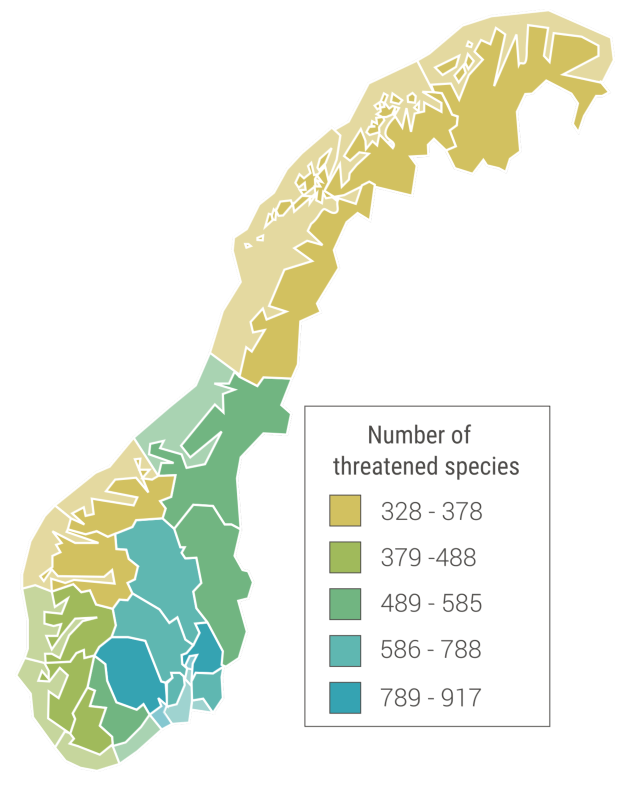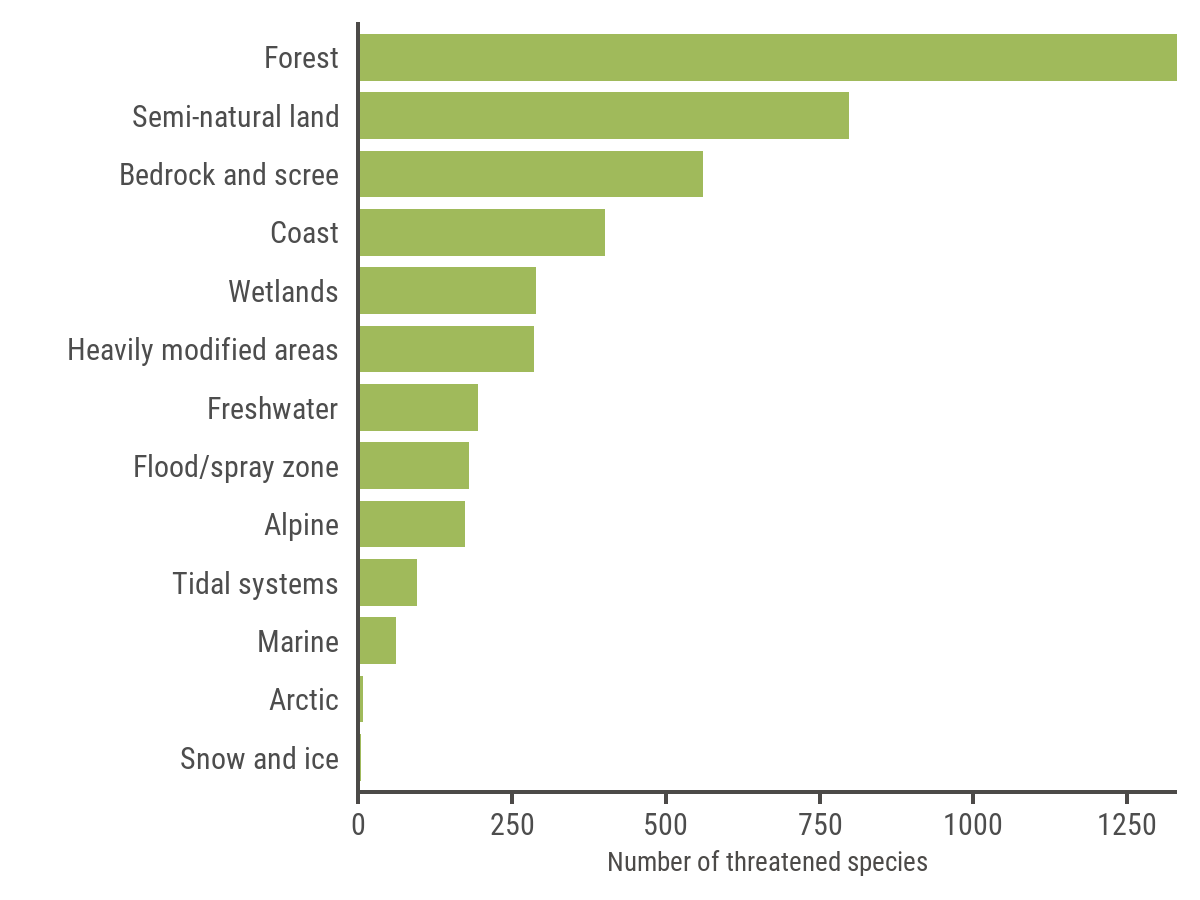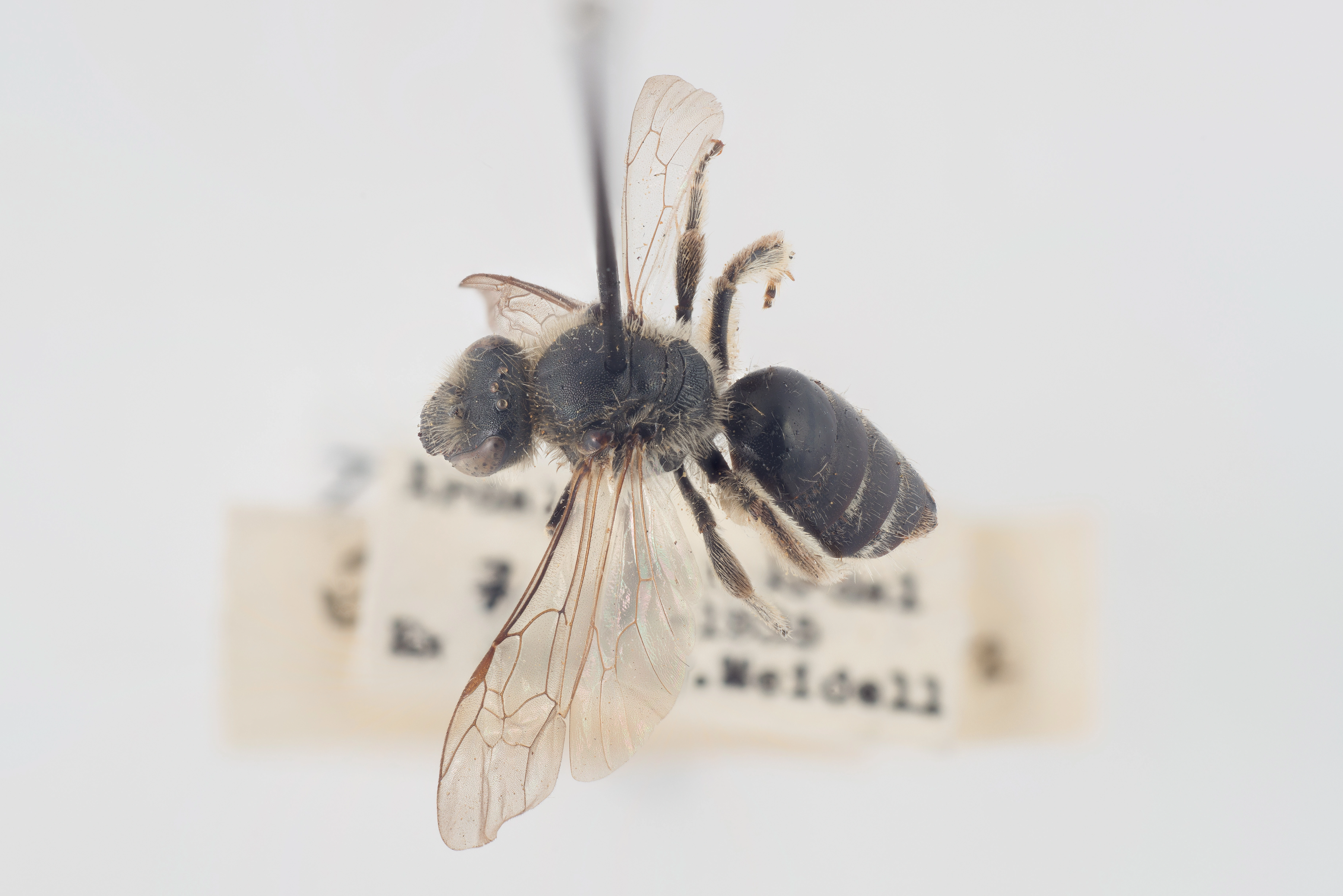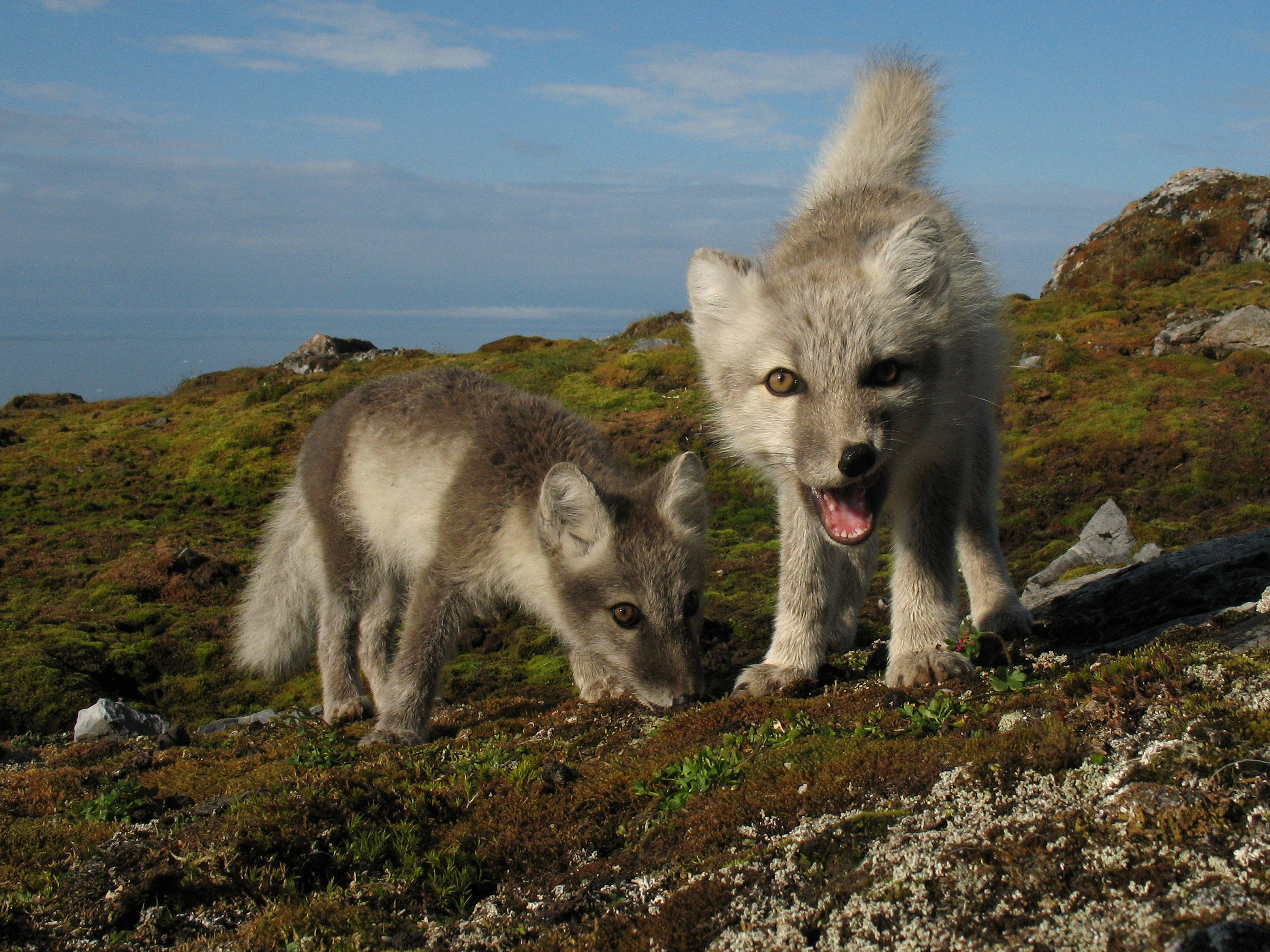Results from the 2021 Red List for Species
The current Norwegian Red List for Species was released in November 2021, and replaces the 2015 Red List. It contains 4957 species, of which 2752 are classified as threatened.
- Innhold
- Number of red-listed species
- Proportion of threatened species
- Where are the threatened species in Norway?
- Many threatened species in forest and semi-natural areas
- Regionally Extinct species
- Why are some common species red-listed?
- Threats
- Changes from 2015 to 2021
- Svalbard
- Cite this page as:
Number of red-listed species
As of November 2021, more than 46 000 species have been recorded in Norway. Red List assessments for mainland Norway and the Norwegian sea areas (excluding Svalbard) have been carried out for 23 405 of these. In other words, we still know too little about half of the species that are found in Norway to make red-list assessments.
Of the species that have been assessed, 4957 (21 %) have been placed on the Red List and 18 448 species (79 %) have been assessed to the category Least Concern. The latter are not classified as red-listed species.
Species on the Norwegian Red List split between categories. Of the 4957 red-listed species, 11.8 % (2752 species) are threatened, i.e., assessed as Critically Endangered (CR), Endangered (EN) or Vulnerable (VU).
Proportion of threatened species
The proportion of threatened species is highest in the species groups birds (26.5 %), mammals (23.9 %), mosses (22.1 %), vascular plants (21.6 %) and lichens (19.2 %).
The razorbill Alca torda (VU) is one of the 62 threatened bird species in Norway.
Where are the threatened species in Norway?
The numbers of threatened species are highest in southeastern parts of Norway, with the largest number in Oslo and Akershus counties (917 species combined), followed by Telemark county (867 species), Buskerud county (788 species), Vestfold county (780 species) and Østfold county (747 species). Troms and Finnmark counties have the lowest number of recorded threatened species (328 and 361 species, respectively).
There are several explanations for these geographical variations. Many species that require a relatively warm climate are found in southeastern Norway, and there is also a wider variety of rare habitats here than in other regions. However, this is also the part of the country where human population density is highest, and where threats and impacts on the environment are the greatest.
Regional distribution of threatened species on the 2021 Red List, by known occurence in counties existing in January 2018.
Many threatened species in forest and semi-natural areas
More species are associated with forest than with any other main habitat in Norway, so it is not surprising that forests also account for the largest proportion of red-listed species. Almost half (48 %) of all threatened species are found in forest, either exclusively or both in forest and in other habitats. The largest numbers of threatened species in forest habitats are in the species groups fungi (387 species), beetles (232 species), lichens (167 species), dipterans (137 species) and lepidopterans (121 species). Many of the threatened species in forest are specialists, for example found on dead wood, large deciduous broad-leaved trees or burnt areas left by forest fires. A large proportion of the red-listed species found in forests are associated with rich broad-leaved forest, even though this only makes up about 1 % of Norway’s productive forest area.
About 29 % of the species listed as threatened are associated with semi-natural habitats, mainly traditionally managed meadows and pasture. These have declined greatly in extent over the past hundred years, and now only make up a small proportion of the total area of Norway.
Only 2 % of the species classified as threatened are marine species. Most of them are birds, fish and annelids. However, the low proportion of threatened species found in the marine environment is partly explained by a huge knowledge gap. This is also reflected in the large number of red-listed marine species that are placed in the category Data Deficient (DD).
Distribution of threatened species by main habitat. Note that a species can occur in several main habitats.
Regionally Extinct species
In all, 107 species are considered to have become extinct in Norway since 1800, and are therefore in the category Regionally Extinct. Approximately half of these (52 species) are beetles. Other species group with fairly many Regionally Extinct species are hymenopterans (19 species), lepidopterans (8 species), vascular plants (8 species) and dipterans (6 species).
There may be a long interval between the last observation of a species and the time when it can be said with some certainty that it has actually become extinct. This can explain the relatively low number of species classified as Regionally Extinct, and the fact that very few species are considered to have become extinct in the past 50 years.
In addition, 40 Critically Endangered species are labelled as possibly extinct. This label is given to Critically Endangered species that possibly have gone extinct already, but where proper documentation still is lacking.
The bee Lasioglossum sexmaculatum has not been seen since the 1930s, despite thorough search efforts, and is considered Regionally Extinct in Norway.
Why are some common species red-listed?
It is important to note that the Norwegian Red List of Species is not a rarity list. Some species are red-listed even though they have very large populations in Norway. For instance, it is estimated that the Atlantic puffin population numbers close to 3 million mature individuals in Norway. Other examples of abundant red-listed species are the wych elm, Atlantic salmon and yellowhammer. Species such as these are red-listed because their populations have declined by more than 15 % during the species' last three generations.
Several game species are red-listed in 2021. This includes for instance the mountain hare, reindeer, great cormorant and common eider. These species are red-listed because their populations have declined considerably.
Wych elm Ulmus glabra (EN)
Threats
The populations of most threatened species are declining. The most prominent threat is land-use change as a result of human activity that causes habitat loss or degradation. However, other threats including pollution, climate change, harvesting and native and alien species can also result in population reductions. In addition, threatened species often have a limited geographical range or small populations.
Land-use change poses a threat to 89 % of the threatened species in Norway. This includes for instance overgrowing of open landscapes after traditional grazing and haymaking have been discontinued, and commercial forestry operations. Land-use change that is not related to agriculture or forestry is listed as a threat to 56 % of the threatened species.
Pollution is considered to be a significant threat to 14 % of all threatened species, including both aquatic and terrestrial species. Climate change is listed as a pressure on 8 % (211 species) of threatened species, mainly mosses and vascular plants. More than half of the threatened species affected by climate change are associated with alpine areas.
Alien species are considered a threat to a little less than 6 % of threatened species in Norway. Harvesting is only listed as a threat to 2 % of all threatened species, but many of these are of commercial importance and some are keystone species in their ecosystems.
The abandoned mountain farm Nedbergo in Sogn and Fjordane county.
Changes from 2015 to 2021
All but one of the species groups that were evaluated for the 2010 and/or 2015 edition of the Norwegian Red List for Species have been re-evaluated for the 2021 Red List. The springtails have not been revisited since the 2010 Red List, which means that those assessments still are valid.
1839 species that never before have been subject to a Norwegian Red List evaluation have been evaluated for the 2021 Red List. Dipterans, annelids, fungi, hymenopterans and crustaceans consitute a large proportion of these new species.
Increase in number of threatened species
A total of 20 568 species have been revised from 2015 to 2021, i.e., they have been evaluated in both editions. Among these, 1523 species (7.4 %) have a different category on the 2021 Red List than what they had in 2015. 309 species have gone from being red-listed in 2015 to being evaluated as Least Concern in 2021. Similarly, 333 species that were considered Least Concern in 2015 have now entered the Red List. The proportion of red-listed species among the revised species has remained stable from the last edition; 20.9 % in 2021 and 20.8 % in 2015. However, the proportion of threatened species among the revised species has increased slightly, from 11.2 % in 2015 to 12.1% in 2021. This constitues a net increase of 188 species in the threatened categories (CR, EN and VU).
More species at increased risk of extinction
700 revised species have moved to a higher category of threat, i.e., a higher risk of extinction compared to in 2015. The largest number of species at increased risk are in the groups vascular plants (181 species) and mosses (124 species). This can partly be explained by an increased understanding of the local and regional effects of climate change on these particular species groups. Also among birds, lichens and lepidopterans the general picure is an increase in extinction risk.
On the other hand, 513 species have moved to a lower category because compared to in 2015. Among those at lower risk of extionctions are several beetles (84 species), fungi (77 species) and dipterans (75 species).
New knowledge is the most prominent cause for category change
There are many reasons for why a species changes category from one edition to the next. New or increased knowledge is the most prominent cause for category change (874 revised species). This can include new knowledge about the species' occurence, occupancy and biology. New knowledge about changes in the species' habitat, for instance from the Norwegian Red List of Ecosystems and Habitat Types 2018, can also result in a different evaluation. New interpretation of existing data has led to category change in 364 revised species. De facto population changes is listed as a cause of category change for just 78 revised species.
Svalbard
Red List evaluations for Svalbard have been undertaken for 485 species from the species groups lichens, vascular plants, birds, mammals and fish. As a result, 29 lichens, 65 vascular plants, 3 mammals and 19 birds have been placed on the Red List for Svalbard. This corresponds to 21.4 % of the evaluated species being red-listed. In addition, 34 subspecies or varieties of vascular plants have been assessed, of which 11 have been red-listed.
Other native species are listed as a threat to 30 of the 67 threatened species in Svalbard. For instance, grazing pressure from the reindeer population poses a threat to several Cladonia lichens. With climate change, the average temperature in Svalbard is expected to increase with about 6 - 7 °C within year 2100 in the RCP4.5 scenario (NCCS, 2019). Climate change is therefore listed as a threat to 27 of the 67 threatened species.
The majority of threatened species in Svalbard (44 species) have been evaluated to one of the three categories due to very small populations. For some of these species, human activity is considered to be of little significance or only to affect an insignificant proportion of their population.
Threatened species are those placed in the categories Critically Endangered (CR), Endangered (EN) or Vulnerable (VU). In Svalbard, 67 species (12.4 % of those evaluated) are in these three categories.
The Arctic fox Vulpes lagopus is Least Concern (LC) in Svalbard, but Endangered (EN) in mainland Norway. The mainland population has increased since the 2015 Red List, when the Arctic fox was evaluated as Critically Endangered (CR), due to extensive conservation measures.
The Norwegian Centre for Climate Services (NCCS) (2019). Climate in Svalbard 2100. Avaliable at: https://www.met.no/kss/_/attachment/download/b8e54e37-3a8b-4672-84cd-2b390af11362:fb82d5bd730f65ac6b9ad6f34dfcb96e5a85d15a/climate-in-svalbard-2100-print.pdf downloaded on 1 December 2021.
Cite this page as:
The Norwegian Biodiversity Information Centre (2021). Results from the 2021 Red List for Species. The Norwegian Red List of Species 2021. http://www.biodiversity.no/Pages/135386/Results_from_the_2021_Red Downloaded on <date>.








